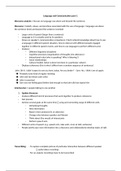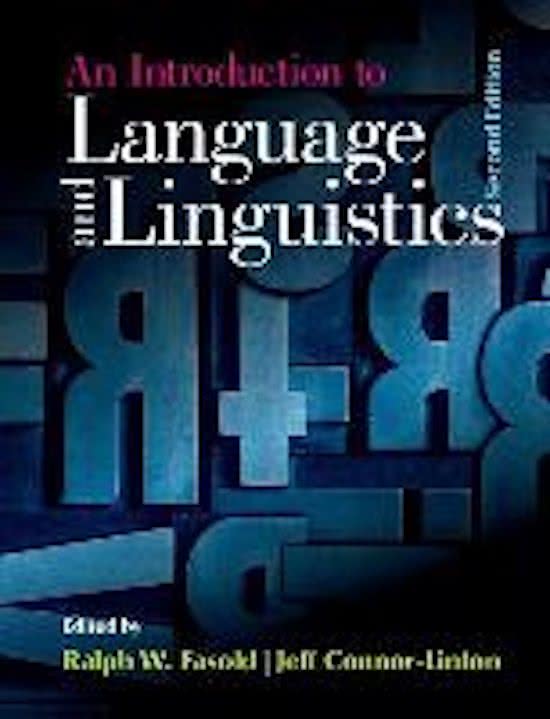Language and Communication part 2.
Discourse analysis = focuses on language use above and beyond the sentence.
Discourse = beliefs, values, and practices associated with the use of language / language use above
the sentence (text) and beyond the sentence (context)
- Larger units of speech (larger than a sentence)
- Language as it is actually used by its speakers
- Draws on speaker’s communicative competence (=tacit cultural knowledge about how to use
a language in different speech situation, how to interact with different people engaged
together in different speech events, and how to use language to perform different acts)
- Involves:
- Different linguistics disciplines
- Cognitive processes (organisation of thoughts into utterance)
- Interactional roles (who is speaking? Who is listening?)
- Social relationships
- Cultural models (what is done/not done in a particular culture)
- Displays coherence (this is why it differs from a random sequence of sentences)
John: Oh hi, I didn’t expect to see you here, today. Are you better? – Sam: Yes, I think I am ok again.
Probably some kind of regular meeting
John and Sam know each other
John is surprised
Sam was not feeling good before bad enough so that John did not expect him
Interlocutors = people talking to one another
1. Spoken discourse
- Involves different kind of processes that work together to produce coherence
- Fast process
- Achieve several goals at the same time using and connecting range of different units
- Verbalising thoughts
- New information
- Repair errors produced in an utterance
- Change roles between speaker and listener
- Think about (the needs) of interactants
- Perform speech acts
- Different units of speech (e.g. speech acts, idea units, turns at talk, sentences)
- People jointly ease new information into a discourse and collaboratively develop topics of talk
Transcribing: - To capture complete picture of particular interaction between different speaker
audio/video recordings
- For an analysis recordings have to be transcribed
, - Apart from words, several other features are noted down:
- features of speech (intonation, volume, non-fluency, pauses)
- aspects of interaction (overlaps between turns of talk)
- aspects of non-vocal interaction (gaze, gesture)
- Transcription is often the first step in the analytical process because you have to
listen to a stretch of discourse again and again
. sentence-final falling intonation
, clause-final intonation (“more to come”)
! exclamatory intonation
? final rise, as in a yes/no question
… pause of ½ second or more
‘ primary stress
CAPS emphatic stress
[ overlapping speech
] no perceptible inter-turn pause
: elongated vowel sound
- glottal stop: sound abruptly cut off
“” dialogue, quoted words
() “pharenthetical” intonation: lower amplitude and pitch plus flattened intonation contour
hhh laughter (h= one second)
= at right of line indicates segment to be continued after another’s turn; at left of line indicates continuation of
prior segment after another’s turn
/?/ inaudible utterance
{} transcriber comment on what is said
2. Written discourse
- Learning to write is different from learning to speak
- Instruction in graphic conventions (printing letters/connecting them together in
script)
- Technology (how to use a keyboard and manage files)
- Punctuation
- Rules of correct grammar
- Explicit process involving instructions and conventions
- Ideas on how we ‘have’ to write have an influence on the way we write
- Difference with respect to standards between the different genres of writing
- Use different aspects of language to maintain reader’s interest and make text relevant to
reader’s needs and goals same as speakers: design discourse for projected recipients
- Written texts have a longer lifespan
Difference between spoken and written discourse
- Speaking is faster than writing
- Speaker can continuously adjust what they say
- Speed leads to fragmentation spoken discourse more fragmented
- Role of recipient (in spoken recipient is co-participant)
, - Slower writing process leads to integration written more integrated
E.g. a. Gina: have you ever smelled a magnolia blossom? Sue: mmm. Gina: Absolutely gorgeous.
b. On one particular morning this summer, there was a certain fragrance that I recognized to
be a glorious magnolia.
Script =
Fragmentation = segmentation of information into small, syntactically simple units of language. Units
present one idea at a time. Units are easy to produce and parse.
Integration = arrangement of information into long, syntactically complex units of language that
present more than one idea at a time. Production and parsing requires more time.
Difference can be seen by looking at the introduction of new referents into discourse
Grammatical intricacy
Spoken discourse Written discourse
- Less complex - More complex
- A more spread out set of clauses - Lots of elaborations
Lexical density
Spoken discourse Written discourse
- Fewer content words - More content words (verbs, nouns) than function
- Content words tend to spread out over number words
of clauses - Many content words in individual clauses
Nominalisation
Spoken discourse Written discourse
- Few nominalisations - Frequent nominalisations
- Relatively short noun groups - Longer noun groups
- High information density
Explicitness
Spoken discourse Written discourse
- Can be as explicit as written language - Generally more explicit than spoken discourse
- Other means to be explicit (gesture, mimics)
Contextualisation
Spoken discourse Written discourse
- Depends on share situation and background - More decontextualized
interpretation - Some genres (e.g. novels) depend on background
- Some genres require less context (e.g. lecture) information so that the reader can identify with
the characters
Spontaneity
, Spoken discourse Written discourse
- Disorganised and ungrammatical - Organised and grammatical
- Overlaps - More constrained in the way meaning can be
- Interruptions conveyed
- Sudden topic change - See only finished product
- Clarification
- Corrections
Repetition, hesitation, and redundancy:
Spoken discourse Written discourse
- Many repetitions
- Many hesitations
- Many redundancies
- Produced in real time, reflects speakers
production process
- Use of fillers ‘hm’, ‘eh’, etc.
Where do new media fit in?
- Short
- Often informal
- Some seem to reflect spoken language
- Emoticons
- Other writing conventions
- Audio
- Video
- Often visual
- Often studied using models for written or spoken language
Focus on the recipient
Spoken discourse
- Recipient provides feedback - Management of changing roles of
- Becomes speaker participants influences flow of discourse
- Alternation of roles
Participation framework
Written discourse
- Writer anticipates information need
- Writer maintains readers interest
- Tries to create involvement with material and intend





